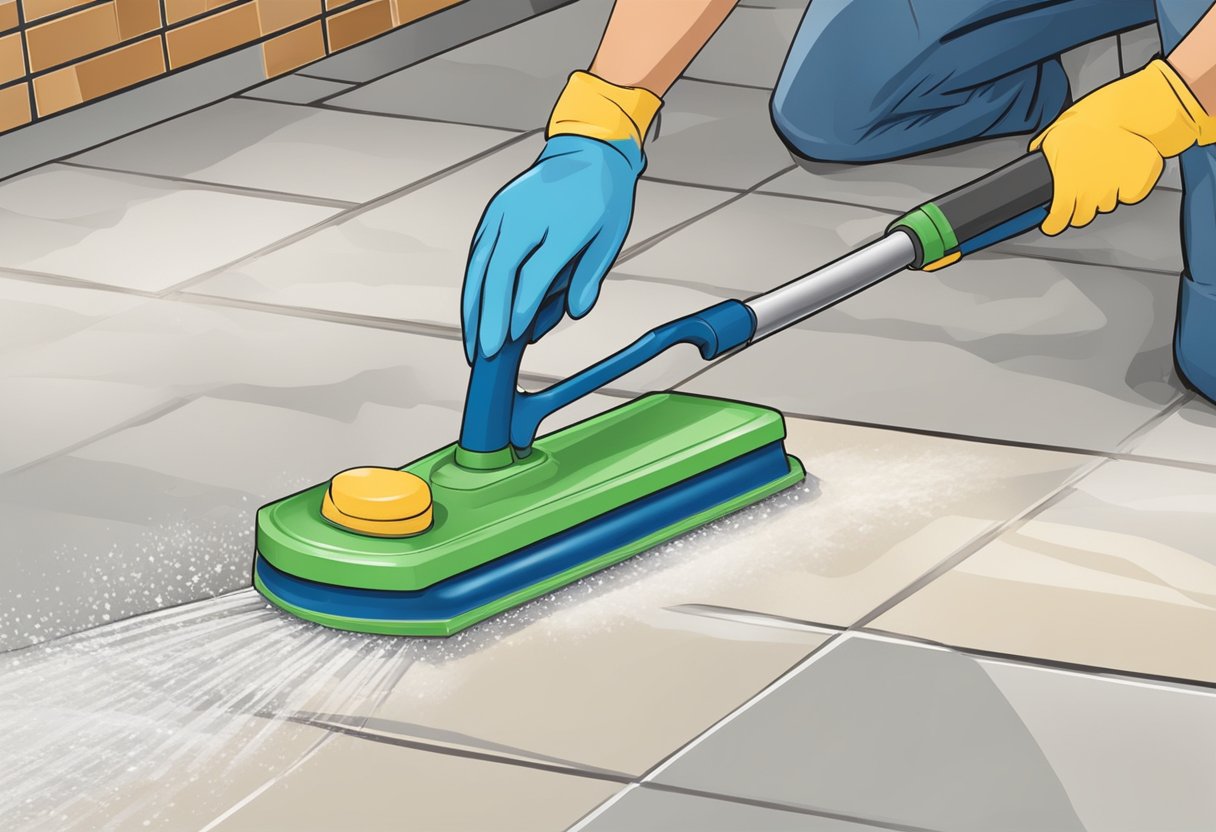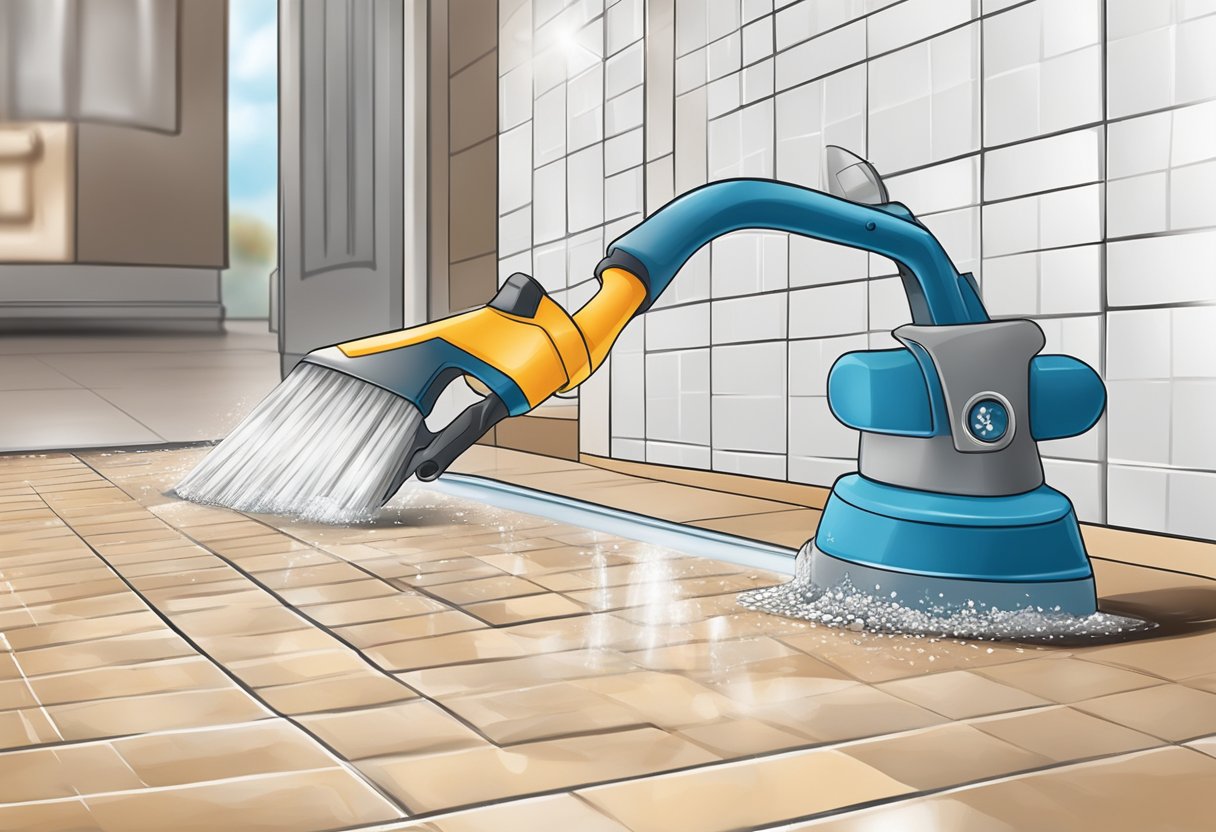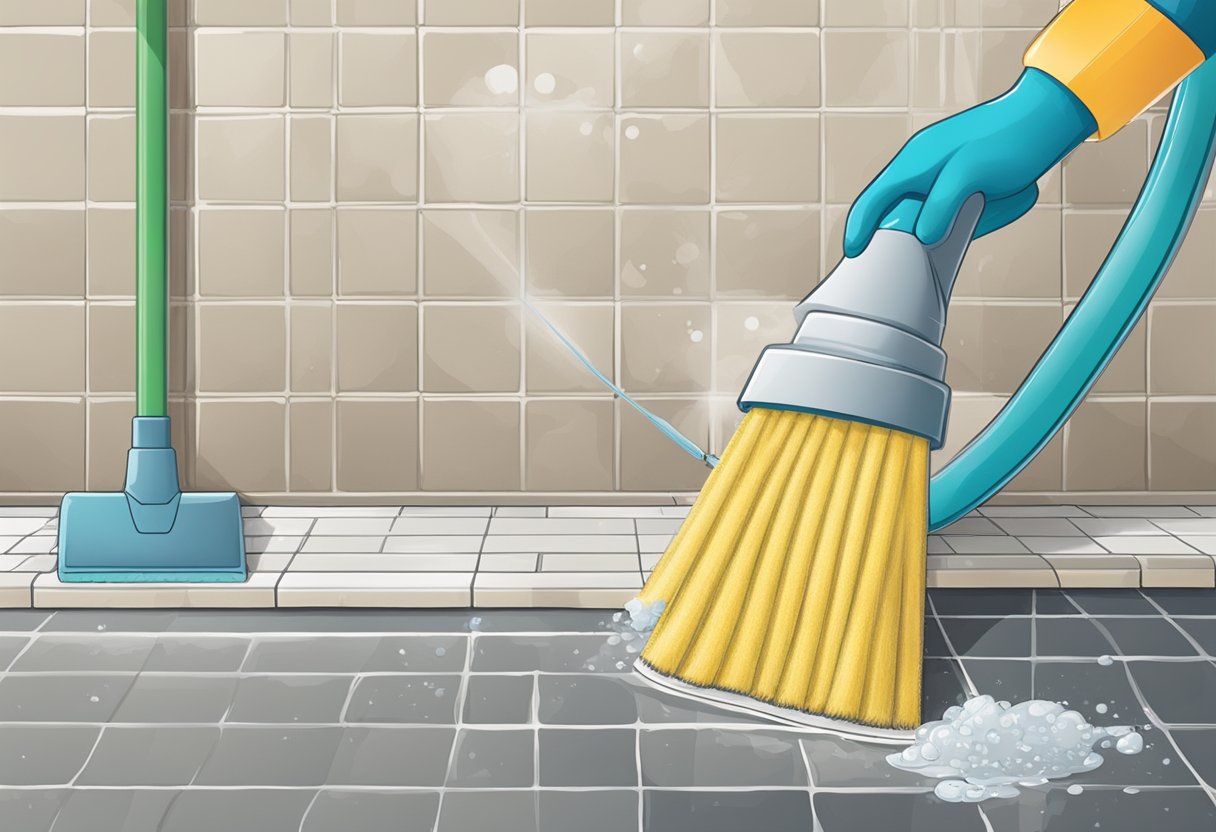Cleaning grout can be a daunting task for many homeowners. Grout is porous and easily traps dirt, grime, and stains, making it difficult to maintain its original appearance. However, regular cleaning of grout is essential to prevent permanent discoloration, mold growth, and other damages that can affect the integrity of your tiles.

When it comes to solving common grout problems in home maintenance, there are several DIY methods and professional cleaning options available. DIY methods range from using baking soda and vinegar to steam cleaning and using specialized grout cleaners. Professional cleaning options include hiring a professional cleaning service or renting specialized cleaning equipment. However, choosing the right cleaning method and supplies can be challenging, especially if you are not familiar with the cleaning process.
Key Takeaways
- Regular cleaning of grout is crucial to prevent permanent discoloration, mold growth, and other damages that can affect the integrity of your tiles.
- DIY grout cleaning methods include using baking soda and vinegar, steam cleaning, and specialized grout cleaners, while professional cleaning options include hiring a professional cleaning service or renting specialized cleaning equipment.
- Choosing the right cleaning method and supplies is essential to effectively clean grout and maintain its original appearance.
Understanding Grout
https://www.youtube.com/watch?v=rn0VfNHpWMc&embed=true
When it comes to cleaning grout, it’s important to understand what grout is and how it works. Grout is a mixture of cement, sand, and water used to fill the gaps between tiles. It’s a porous material that can absorb dirt, grime, and moisture, making it prone to discoloration and staining.
There are two main types of grout: epoxy grout and cementitious grout. Epoxy grout is made from polymers and is more durable and resistant to stains than cementitious grout. Cementitious grout, on the other hand, is made from cement and is more prone to staining and discoloration.
Cementitious grout comes in two varieties: sanded and unsanded. Sanded grout is used for wider gaps between tiles, while unsanded grout is used for narrower gaps. The sand in sanded grout helps to reinforce the grout and prevent cracking.
Polymers are often added to grout to improve its flexibility, durability, and resistance to stains. These additives can also make the grout easier to clean.
When cleaning grout, it’s important to choose the right cleaning product for the type of grout you have. Some cleaning products can damage or discolor certain types of grout. It’s also important to avoid using abrasive cleaners or tools that can scratch or damage the surface of the grout.
In summary, understanding the type of grout you have and its properties is essential for choosing the right cleaning method and product. Whether you have epoxy grout or cementitious grout, sanded or unsanded, understanding the properties of your grout can help you keep it looking fresh and clean.
The Importance of Regular Grout Maintenance

As someone who has dealt with dirty and stained grout lines before, I cannot stress enough the importance of regular grout maintenance. Whether it’s in the kitchen, bathroom, shower, backsplash, or countertops, grout lines are notorious for collecting dirt, grime, and even mold.
But why is regular maintenance so important? Here are a few reasons:
Prevents Staining and Discoloration
Grout lines are porous, which means they can easily absorb liquids and dirt. This can cause staining and discoloration over time. However, regular cleaning and sealing can help prevent this from happening.
Extends the Life of Your Tiles
Dirty grout can actually damage your tiles over time. When dirt and grime build up, it can scratch and wear away at the surface of your tiles. This can lead to costly repairs or even replacement. By maintaining clean grout lines, you can extend the life of your tiles.
Promotes a Healthier Environment
Dirty grout can also be a breeding ground for mold and bacteria. This can be particularly problematic in areas like the bathroom or kitchen where moisture is present. Regular maintenance can help prevent the growth of mold and bacteria, promoting a healthier environment.
So, what does regular maintenance entail? Here are a few tips:
- Wipe down your tiles and grout lines regularly with a damp cloth or mop.
- Use a mild cleaning solution and a stiff-bristled brush to scrub away dirt and grime.
- Seal your grout lines every year or so to prevent staining and damage.
By following these simple steps, you can keep your grout lines looking clean and fresh for years to come.
Common Grout Problems

Cleaning grout can be a challenge, especially when it comes to stubborn stains, mildew, and mold. Here are some common grout problems that I have encountered and how I have dealt with them.
Stains
Stains are perhaps the most common grout problem. They can be caused by spills, dirt, and even hard water. To remove stains, I usually start by scrubbing the grout with a mixture of baking soda and water. If the stain persists, I use a commercial grout cleaner that contains bleach. I apply the cleaner to the stained area, let it sit for a few minutes, and then scrub the grout with a stiff-bristled brush.
Mildew and Mold
Mildew and mold thrive in damp environments, making grout a prime location for their growth. To remove mildew and mold, I use a solution of equal parts water and vinegar. I apply the solution to the affected area and let it sit for about 10 minutes. Then, I scrub the grout with a brush and rinse it with water. For more stubborn cases, I use a commercial mold and mildew remover.
Soap Scum
Soap scum is a common problem in bathrooms. It can build up on grout and make it look dirty and discolored. To remove soap scum, I use a mixture of baking soda and water. I apply the mixture to the affected area and let it sit for a few minutes. Then, I scrub the grout with a brush and rinse it with water.
Dirty Grout
Dirty grout can make an entire room look unclean. To prevent dirt buildup, I sweep or vacuum the floors regularly. When it comes to cleaning, I use a steam cleaner to deep clean the grout. I fill the steam cleaner with water and run it over the grout. The steam penetrates the grout and lifts dirt and debris.
Damage
Grout can become damaged over time, especially in high-traffic areas. If the grout is cracked or missing, I remove the damaged grout with a grout saw or scraper. Then, I mix new grout according to the manufacturer’s instructions and fill in the gaps. After the new grout has dried, I seal it to prevent future damage.
Overall, cleaning grout requires patience and persistence. By using the right tools and techniques, I have been able to tackle even the toughest grout problems.
DIY Grout Cleaning Methods
https://www.youtube.com/watch?v=tznEz4acbWU&embed=true
Cleaning grout can be a tedious and time-consuming task, but it doesn’t have to be. Here are some DIY methods that I have found to be effective in cleaning grout.
Vinegar Solution
One of the easiest and most effective ways to clean grout is by using a vinegar solution. Mix equal parts of white vinegar and water in a spray bottle and apply it to the grout. Let the solution sit for a few minutes before scrubbing it with a stiff-bristled brush. Rinse the area with water and dry it with a clean cloth.
Baking Soda Paste
Another DIY method for cleaning grout is by using a baking soda paste. Mix baking soda and water to create a thick paste and apply it to the grout lines. Let it sit for a few minutes before scrubbing it with a brush. Rinse the area with water and dry it with a clean cloth.
Hydrogen Peroxide
Hydrogen peroxide is another effective cleaning agent for grout. Mix hydrogen peroxide and water in equal parts and apply it to the grout. Let it sit for a few minutes before scrubbing it with a brush. Rinse the area with water and dry it with a clean cloth.
Elbow Grease
Sometimes the best way to clean grout is by using good old-fashioned elbow grease. Scrubbing the grout lines with a stiff-bristled brush and a cleaning solution can be effective in removing dirt and grime.
Overall, cleaning grout can be a challenging task, but with these DIY methods, it can be done easily and effectively.
Professional Grout Cleaning Options
https://www.youtube.com/watch?v=sOqkZSAOZjA&embed=true
If you’re struggling to clean your grout, you might want to consider hiring a professional. Professional grout cleaning services have access to specialized equipment and cleaning solutions that can remove even the most stubborn stains. Here are a few options to consider:
Steam Cleaning
One of the most effective ways to clean grout is with a steam cleaner. A steam cleaner uses high-pressure steam to clean and sanitize surfaces. When used on grout, the steam penetrates deep into the pores of the grout, loosening dirt and stains. You can purchase a steam cleaner or rent one from a home improvement store. When using a steam cleaner, be sure to follow the manufacturer’s instructions carefully.
Grout Cleaning Attachment
If you already own a steam cleaner, you may be able to purchase a grout cleaning attachment. This attachment is designed specifically for cleaning grout and can be used with your existing steam cleaner. The attachment features a small brush that fits into the grout lines, allowing you to clean them thoroughly. Be sure to choose an attachment that is compatible with your steam cleaner.
Professional Cleaning Services
If you don’t want to invest in a steam cleaner or attachment, you can hire a professional grout cleaning service. These services use specialized equipment and cleaning solutions to remove dirt and stains from grout. They can also seal your grout to help prevent future stains. When choosing a professional service, be sure to read reviews and ask for references. You can also ask for a quote before committing to a service.
Steam Mop
If you’re looking for a more affordable option, you might consider using a steam mop. A steam mop works similarly to a steam cleaner, but is designed for use on floors. Some steam mops come with a grout cleaning attachment, while others can be used to clean grout directly. Be sure to choose a steam mop with adjustable steam settings so you can control the intensity of the steam.
Choosing the Right Cleaning Supplies

Cleaning grout can be a daunting task, but with the right cleaning supplies, it can be a breeze. Here are some tips on choosing the right cleaning supplies for the job.
Sponge
A sponge is a must-have when it comes to cleaning grout. It is a versatile tool that can be used for both wet and dry cleaning. When choosing a sponge, look for one that is soft and absorbent. Avoid using abrasive sponges as they can scratch the grout.
Grout Brush
A grout brush is a specialized brush that is designed to clean grout. It has stiff bristles that can get into the crevices between tiles. When choosing a grout brush, look for one that is small enough to fit into tight spaces. A good grout brush should also have a comfortable grip to prevent hand fatigue.
Stiff Bristle Brush
A stiff bristle brush is another option for cleaning grout. It is more abrasive than a grout brush and can be used to remove tough stains. When choosing a stiff bristle brush, look for one with bristles that are strong enough to remove stains but not so strong that they damage the grout.
Squeegee
A squeegee is a tool that is used to remove excess water from surfaces. It can be used to dry the grout after cleaning. When choosing a squeegee, look for one with a comfortable grip and a blade that is the right size for the job.
In conclusion, choosing the right cleaning supplies is essential for cleaning grout effectively. A sponge, grout brush, stiff bristle brush, and squeegee are all useful tools to have in your cleaning arsenal.
Preventing Grout Stains and Damage

As someone who has spent a fair amount of time cleaning grout, I can confidently say that prevention is key when it comes to keeping your grout looking great. Here are some tips to help prevent stains and damage to your grout:
- Seal your grout: One of the best things you can do to protect your grout is to seal it. Grout is porous, which means it can absorb liquids and stains easily. By sealing your grout, you create a barrier that helps prevent liquids and stains from penetrating the surface. There are many grout sealers available on the market, so be sure to choose one that is appropriate for your type of grout.
- Clean up spills promptly: Whether it’s oil, wine, or coffee, spills can wreak havoc on your grout. As soon as you notice a spill, clean it up right away. Use a clean, damp cloth to blot up the spill, and then follow up with a grout cleaner if necessary.
- Avoid abrasive cleaners: Abrasive cleaners can scratch and damage your grout, so it’s best to avoid them. Instead, opt for a cleaner that is specifically designed for grout. Look for a cleaner that is pH-neutral and non-toxic.
- Be gentle: When cleaning your grout, be gentle. Scrubbing too hard can cause the grout to flake or break. Use a soft-bristled brush or sponge, and be sure to rinse thoroughly with water after cleaning.
By following these tips, you can help prevent stains and damage to your grout, keeping it looking great for years to come.
How to Deal with Tough Stains
https://www.youtube.com/watch?v=gg5J_qCE5tE&embed=true
When it comes to tough grout stains, it’s important to use the right cleaning solution to effectively remove them. Here are some tips and tricks that I’ve found to be helpful:
- For stains caused by mold or mildew, I recommend using a solution of equal parts water and chlorine bleach. Apply the solution to the stained area and let it sit for about 10 minutes before scrubbing with a stiff brush. Be sure to wear gloves and work in a well-ventilated area when using bleach.
- If you have white grout and are dealing with tough stains, I suggest using a paste made from baking soda and water. Apply the paste to the stained area and let it sit for about 10 minutes before scrubbing with a brush. This method is gentle enough for white grout and won’t cause any discoloration.
- For tough stains that won’t budge, I recommend using a Magic Eraser. Wet the eraser and gently scrub the stained area. The eraser should remove the stain without damaging the grout. Keep in mind that this method may not work on all types of stains.
- If you prefer to use natural cleaning solutions, a paste made from baking soda, hydrogen peroxide, and dish soap can be effective at removing tough stains. Apply the paste to the stained area and let it sit for about 10 minutes before scrubbing with a brush.
Remember, it’s important to test any cleaning solution on a small, inconspicuous area of your grout before using it on a larger scale. This will help you avoid any damage or discoloration to your grout.
Using Homemade Cleaning Solutions
https://www.youtube.com/watch?v=ifeSybjr2RY&embed=true
As someone who prefers natural cleaning solutions, I have found that homemade grout cleaners can be very effective. One of my favorite homemade cleaning solutions for grout is a mixture of dish soap and warm water.
To make this solution, I mix a few drops of dish soap with warm water in a spray bottle. Then, I spray the solution onto the grout and let it sit for a few minutes. After that, I use a stiff-bristled brush to scrub the grout and rinse it with warm water. This method is gentle yet effective, and it works well for regular cleaning.
Another homemade cleaning solution that I have found to be effective is a mixture of baking soda and hot water. To make this solution, I mix baking soda and hot water in a bowl until it forms a paste. Then, I apply the paste to the grout and let it sit for a few minutes before scrubbing it with a brush and rinsing it with warm water. This method is great for removing tough stains and grime.
It’s important to note that homemade cleaning solutions may not work as well as commercial cleaners for heavily stained or dirty grout. In those cases, it may be necessary to use a stronger cleaner or hire a professional cleaning service. However, for regular cleaning and maintenance, homemade solutions can be a great option.
Overall, I find that using homemade cleaning solutions for grout is an affordable and eco-friendly way to keep my tiles looking clean and fresh.
Safety Measures When Cleaning Grout
As someone who has cleaned grout many times, I know that it can be a tough job. However, it’s important to remember that safety should always come first. Here are some safety measures to keep in mind when cleaning grout:
1. Wear Protective Gear
When using caustic or acidic cleaners, it’s important to wear protective gear to avoid skin and eye irritation. I recommend wearing gloves, safety goggles, and a mask to protect yourself from harmful fumes.
2. Ventilate the Area
Make sure to ventilate the area you’re working in. Open windows or use a fan to circulate the air and prevent the buildup of fumes. This is especially important when using acidic cleaners, as they can release harmful vapors.
3. Read the Label
Always read the label of the cleaner you’re using and follow the instructions carefully. Some cleaners may require dilution or have specific application instructions. It’s important to follow these instructions to avoid damaging your grout or surfaces.
4. Test in a Small Area
Before using a cleaner on a large area of grout, test it in a small, inconspicuous area first. This will help you determine if the cleaner is safe for your specific grout and surface. If you notice any discoloration or damage, stop using the cleaner immediately.
5. Use Caution with Acidic Cleaners
Acidic cleaners can be effective for removing tough stains, but they can also damage certain types of grout. If you have natural stone or colored grout, avoid using acidic cleaners altogether. Instead, opt for a neutral cleaner or a cleaner specifically designed for your type of grout.
By following these safety measures, you can effectively clean your grout without putting yourself or your surfaces at risk.
Preserving Your Grout After Cleaning
Now that you’ve put in the effort to clean your grout, you want to make sure it stays clean for as long as possible. Here are some tips for preserving your grout after cleaning:
- Apply a grout sealer: A grout sealer helps to protect your grout from future stains and discoloration. After cleaning your grout, allow it to dry completely and then apply the sealer according to the manufacturer’s instructions. This will help to keep your grout looking clean and fresh for a longer period of time.
- Use a daily shower cleaner: To keep your grout looking clean in between deep cleans, use a daily shower cleaner. Simply spray it on your grout and wipe it clean with a damp cloth. This will help to prevent soap scum and mildew from building up on your grout.
- Wipe down your shower after each use: To prevent soap scum and mildew from building up on your grout, wipe down your shower after each use. Use a squeegee or a microfiber cloth to remove any excess water and soap residue from your shower walls and floor.
- Avoid using harsh chemicals: Harsh chemicals can damage your grout and cause it to deteriorate over time. Instead, use gentle cleaners and natural ingredients like baking soda and vinegar to clean your grout.
By following these tips, you can help to preserve your grout and keep it looking clean and fresh for a longer period of time.
Conclusion
In conclusion, maintaining clean grout is important for the overall appearance of your tiled surfaces. Whether you choose to clean your grout yourself or hire a professional, there are a few key takeaways to keep in mind.
For those who prefer a DIY approach, there are a variety of effective methods for cleaning grout using common household products. Some popular options include using baking soda and vinegar, hydrogen peroxide and baking soda, or a steam cleaner. When using these methods, it is important to wear gloves and eye protection, and to test a small, inconspicuous area before proceeding with the entire surface.
Regular maintenance is also key to keeping your grout clean. This can include wiping down tiled surfaces after use, using a squeegee to remove excess water, and avoiding harsh chemicals that can damage grout over time.
If you decide to hire a professional, be sure to do your research and choose a reputable company with experience in cleaning grout. Ask for references and read reviews to ensure that you are getting quality service.
Overall, whether you choose to clean your grout yourself or hire a professional, taking steps to maintain clean grout will help to keep your tiled surfaces looking their best for years to come.
Frequently Asked Questions
What are some effective grout cleaning hacks?
There are several effective grout cleaning hacks that you can try at home. Some of these include using baking soda and vinegar, hydrogen peroxide, or a Magic Eraser. You can also try using a steam cleaner or a grout brush to remove stubborn stains.
What is the best commercial grout cleaner?
There are many commercial grout cleaners available on the market, but some of the most effective ones include Clorox Tilex, Zep Grout Cleaner, and Black Diamond Ultimate Grout Cleaner. When choosing a commercial grout cleaner, make sure to read the instructions carefully and test it on a small, inconspicuous area first.
How can I whiten grout without damaging it?
To whiten grout without damaging it, you can try using a mixture of baking soda and hydrogen peroxide. Apply the paste to the grout and let it sit for a few minutes before scrubbing it with a toothbrush. You can also try using a mixture of vinegar and water or bleach and water, but make sure to dilute the bleach properly and avoid using it on colored grout.
What is the most efficient grout cleaning tool?
The most efficient grout cleaning tool is a grout brush. This type of brush is specifically designed to clean grout lines and can easily remove dirt and stains. You can also try using a steam cleaner or a toothbrush for hard-to-reach areas.
Does hydrogen peroxide work well for cleaning grout?
Yes, hydrogen peroxide is an effective cleaner for grout. It can help remove stains and brighten the grout without damaging it. However, make sure to dilute the hydrogen peroxide properly and avoid using it on colored grout.
Is vinegar or bleach a better option for cleaning grout?
Both vinegar and bleach can be effective for cleaning grout, but they work in different ways. Vinegar is a natural cleaner that can help remove dirt and stains, while bleach is a powerful disinfectant that can kill bacteria and mold. If you choose to use bleach, make sure to dilute it properly and avoid using it on colored grout.
